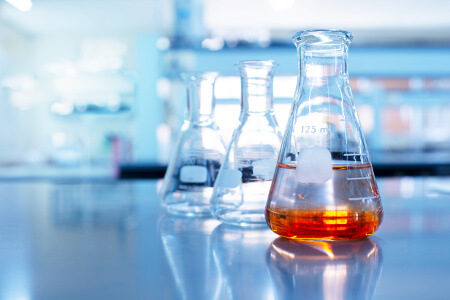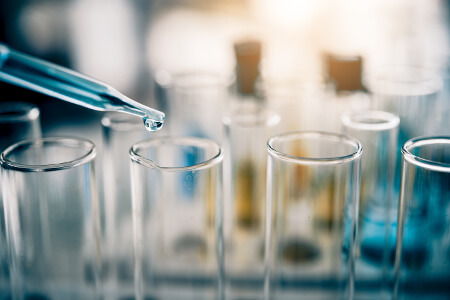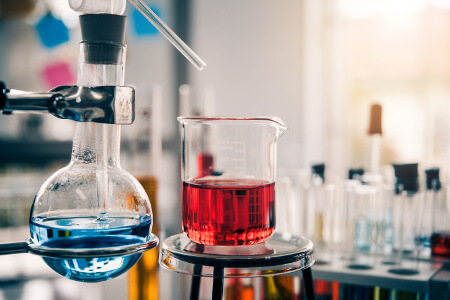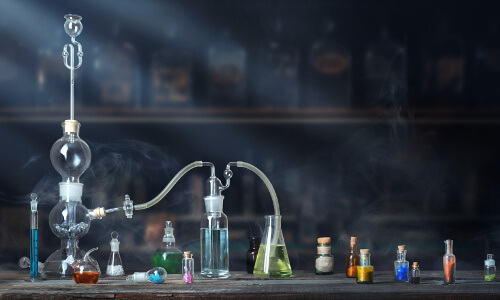
Digital scales, balances and moisture analyzers are invaluable tools in the field of chemistry. Dosing is essential for chemistry: a chemical that is harmless or beneficial in certain quantities can become toxic or volatile when mixed with reagents. But chemistry is a field with a lot of variation, and it can be difficult to understand which weighing devices to use. In this post, we’ll go over the different types of scales, balances and moisture analyzers, and where they fit in within the domain of chemistry.
Weighing for Chemistry
Weighing instruments are primarily used for quantitative chemical analysis, which is used to determine the amount or percentage of a substance within matter (this is usually called gravimetric analysis). Various types of reactions are provoked in order for the sample to reveal substances and their quantities.
Usually, gravimetric analysis starts with the creation of a solution. The sample and reagents are weighed individually before they’re combined into a solution. The solution goes through a reaction that separates the substance being analyzed. That substance, now separated, is weighed. From that weight, chemists can calculate how much of that substance was present in the sample and can calculate further to extrapolate the average compound and the amount of the substance present within that compound.

This is a simplified explanation; some substances go through many different reactions to further separate, purify and filter them. Reactions can range from the creation of a new compound to precipitation, oxidation and more.
While volumetric analysis, as the name indicates, primarily uses volume to quantify a substance, compounds and samples are often weighed before undergoing various chemical reactions. It’s not always possible or easy to weigh the compounds resulting from titration, burning or other reactions (some of them become gasses, for example) so their mass has to be calculated from volume if it cannot be weighed on a balance.
Even if the resulting compound is not weighed, the chemicals necessary for the reactions are. In addition, reagents are often used in specific ratios and percentages. Using a balance can help reduce waste and ensure the proper chemical reactions take place by weighing the liquid then calculate the specific amount you need for the reaction. Balances with formulation features are especially well-suited for mixing tasks, since they allow users to perform all necessary calculations with the balance. Percentage weighing is also very important when scaling reagent and mixes, as it simplifies complex titration tasks by allowing users to measure each component as a percentage of the final weight.

Semi-Micro and Analytical Balances
For highly complex work that necessitates high levels of accuracy and precision, you need to use a semi-micro or analytical balance. While they feature a fairly low capacity (ours can go up to 510g), they offer readabilities as precise as 0.01mg, which is essential when measuring small amounts after putting a substance through numerous reactions.
While many samples are first measured in higher quantities, once they are processed, filtered, mixed with reagents, or isolated from a solution, the matter resulting from such tests tends to be very small and must be measured extremely accurately. This can be very useful when reducing the amount of contaminants in a substance to measure the exact amount of a pure chemical within a mixture.
Analytical balances are frequently used to measure reagents and the product resulting from chemical reactions like digestion in analytical chemistry. This can help reduce waste and potentially toxic by-products. The draft shield on these balances can also be helpful when weighing small quantities and to help prevent contamination or oxidation.
In addition to their accuracy and precision, analytical and semi-micro balances feature low uncertainty, which is essential when working with materials that can be unstable or toxic. Pharmaceutical compounds often need to be weighed precisely and with low uncertainty as well. Crops, soil, water and food are frequently tested for pollutants and contaminants. Because we frequently use compounds such as fertilizers without long-term testing, it’s important for chemists to record the most minute changes to make sure these compounds are not slowly affecting their environment. Heavy metals be toxic even in small quantities, so their accumulation must be measured precisely.

The way this type of data is regulated is extremely specific and strict and must adhere to various standards to ensure repeatability. A balance with low uncertainty can help bolster claims and results, and ensure comparative experiments conform to a high standard. When purchasing a lab balance, you must make sure its class and tolerances match your requirements.
These balances often include a wide variety of features, including density measurements, formulation, counting, accumulation, percentage weighing and more. They allow users to simplify complex weighing tasks and can perform calculations on the balance instead of having to go back and forth with different computer applications or devices. Some analytical and semi-micro balances can even store testing or formulation procedures for quick recall of frequently used procedures. Taking advantage of these features can also simplify scaling experiments by removing the need for additional calculations.
Percentage weighing is particularly appreciated in chemistry labs, where solutions have various levels of concentration depending on the sample’s type. Food and pharmaceutical labs are especially dependent on ratios and percentages, since they’re a quick way to show something’s concentration or nutritional value. Percentage weighing is also useful for microbial cultures, since media is often a combination of liquid or dehydrated medium mixed with agar or gelatin in specific percentages. Some organisms have complex nutritional requirements requiring a careful balance of various components such as peptone and yeast extracts.
Weighing small quantities is essential in analytical chemistry. Semi-micro balances are used for more specialized tasks, such as differential weighing (repeatedly weighing a solid after placing it into another vessel to measure the amount transferred) in order to obtain particulate sampling for composition data, filter weighing, calibration (including pipette calibration), drying measurements that cannot be undertaken with a moisture analyzer, and coating measurements (for example, anti-static films measuring less than a millimeter on electronic devices).

Density
Mass and volume are among the most important measurements taken in a chemistry lab, and that’s where density comes in. These three properties can tell scientists a lot about the chemicals they’re studying. Many of our lab balances offer density kits that can be placed on the balance’s weighing pan or under the balance using a hook. Density is useful because it’s a fundamental property of matter. While temperature affects density, quantity does not. It doesn’t matter if you measure a gram or a kilo of the same steel, they will both have the same density provided that all the conditions are the same. That means density is an intensive property of matter.
Scientists can use density to not only figure out what various substances are, but how they will react to various ambient changes. For example, a large body of water tends to be warmer on top, with the water getting colder as you go deeper. But in cold temperatures, if a sheet of ice forms, the ice will be floating on top, and the water under the ice is colder right underneath it, and progressively gets warmer as you go deeper. If a scientist had to design a submarine, they would have to take the temperature changes into account since they can affect the density of the water, which could in turn affect the buoyancy of the submarine.
Liquids can also be mixed and still exhibit different densities (for example, water and oil). If a company creates a cough syrup from various ingredients, they have to make sure the syrup’s various compounds will remain mixed once it’s bottled. For example, many salad dressings have to be shaken before consumption because their various elements slowly separate over time.

Precision Balances
Precision balances offer a higher capacity than analytical and semi-micro balances (up to 15kg higher) at the cost of some readability (Adam models range from 0.001g to 2g). They’re don’t offer such fine measurements, but they’re also less susceptible to ambient changes and can be stabilized more quickly and easily. Precision balances can include lower capacity, higher readability models with draft shields and high capacity, low readability top-loading models that do not include draft shields for larger samples.
They’re used most often for preparative work like processing samples, preparing solutions and measuring reagents. Many laboratories have required sample sizes to make sure reactions yield enough product to be measured accurately, especially when looking for compounds that only make up a small percentage of the full chemical. Specific sample size requirements can also make measuring reagents easier since chemists can use proportional quantities instead of measuring out very specific quantities every time.
Their sturdy construction and quick stabilization also makes them well-suited to pilot production for mixing chemicals in production environments.
Some precision balances can still offer complex weighing functions. For example, checkweighing can be useful when sampling solid materials, while formulation can be used for aggregates like adhesives, which can be more demanding to work with.

It’s not uncommon for chemists to measure dry reagents or solid samples on a precision balance, then measure the result of a reaction on an analytical balance. Precision balances are usually the first step for weighing compounds. They’re well-suited for applications like materials testing and quality assurance thanks to their high capacity, sturdy construction and relatively high precision (when compared to a compact or bench scale).
Some precision balances are portable, which means they can be transported for field measurements. These balances should be sturdy, easy to clean and offer a fast stabilization time. However, they tend to be less precise than their lab-bound counterparts, so they’re most often used for preliminary field sampling.
Compact precision balances are often used in educational settings as well. Chemistry classes often have students use balances with a readability around two decimal places to get students used to reagent preparation and more complex weighing tasks.
Moisture Analysis and Chemistry
Moisture analysis can be used when the amount of water in a compound needs to be quantified. The process can also be used to dry a sample before mixing it in a solution when water would dilute it too much to create the desired results. Moisture analyzers are faster than ovens, can heat more evenly and often offer more control over time and temperature for less money. They can do a lot of the calculations, which can considerably reduce user error. The only downside of a moisture analyzer is low capacity, but samples are rarely dried or heated in large batches, especially if they’re volatile or toxic.

Our PMB moisture analyzer allows users to use three different heating modes, which is especially convenient for chemicals that change as they heat up. It ensures users can completely dry a sample evenly without burning it.
Moisture can play a huge role in a compound’s texture, shelf life and storage. Products that are too moist are prone to bacterial or fungal colonization, while products that are too dry can be difficult to use or flammable. Concrete with too much water can crack easily, while concrete that’s too dry will not cure properly, resulting in a weaker bond. Moisture analyzers are essential tools for chemistry labs that specialize in quality or material testing. For a more specific example, check out our previous post on the chemistry of wastewater analysis.
Data Communication
Our balances for chemistry all include RS-232 interfaces to communicate with computers and printers. Some of our lab balances even include USB interfaces to ensure your data can be transferred as efficiently as possible. They’re also compliant with GLP guidelines to ensure a smooth recording process and help with traceability requirements. Take advantage of balance’s ability to communicate with LIMS to reduce the need for manual notetaking and prevent errors, particularly with small numbers and repeated weighing tasks. The balance can automatically track the time, date, results and more. Software can even be used to control a balance remotely, which can be very useful when weighing toxic or radioactive chemicals, or if you’re using the balance to weigh samples in a fume hood.
Because chemistry encompasses so many different types of procedures, we’re only looking at a few examples of most frequently used tests. If you need a balance for a specific application or want to learn more about balances and their uses in chemistry, contact us. We’re happy to help you.

